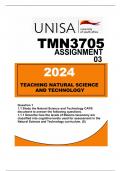, TMN3705 ASSIGNMENT 03 DUE 02 AUGUST 2024
1.1 Study the Natural Science and Technology CAPS document to answer
the following questions.
1.1.1 Describe how the levels of Blooms taxonomy are classified into
cognitive levels used for assessment in the Natural Science and
Technology curriculum. (5
In the Natural Science and Technology Curriculum Assessment Policy Statement (CAPS), Bloom's
taxonomy is used as a framework to classify cognitive levels for assessment. Bloom's taxonomy
categorizes cognitive levels into six stages: Knowledge, Comprehension, Application, Analysis, Synthesis,
and Evaluation.
The first level, Knowledge, requires students to demonstrate an understanding of basic facts, concepts,
and principles in the subject matter. This level focuses on recalling information and identifying key terms
and ideas.
The second level, Comprehension, requires students to demonstrate an understanding of the meaning
and significance of the information presented. This level focuses on interpreting, summarizing, and
explaining ideas in their own words.
The third level, Application, requires students to apply the knowledge they have gained to solve
problems and make connections between concepts. This level focuses on using information in new
situations and scenarios.
The fourth level, Analysis, requires students to break down information into its components and identify
patterns and relationships. This level focuses on identifying cause and effect relationships, making
comparisons, and drawing conclusions.
The fifth level, Synthesis, requires students to combine information from different sources to create new
ideas and solutions. This level focuses on creating original work, generating hypotheses, and designing
experiments.
The sixth level, Evaluation, requires students to assess the validity and value of information, arguments,
and solutions. This level focuses on making judgments based on criteria and evidence.
Overall, Bloom's taxonomy provides a comprehensive framework for assessing cognitive levels in the
Natural Science and Technology curriculum, allowing educators to design assessments that target
specific learning outcomes at each stage. By understanding the different levels of Bloom's taxonomy,
teachers can create assessments that promote critical thinking, problem-solving, and higher-order
thinking skills in students.
Reference:




